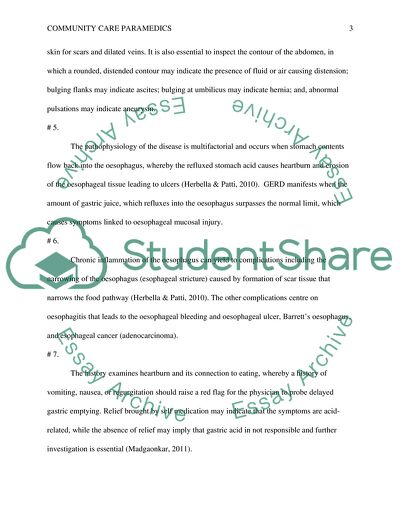
- Home
- Free Samples
- Premium Essays
- Editing Services
- Extra Tools
- Essay Writing Help
- About Us
- Studentshare
- Subjects
- Health Sciences & Medicine
- Community Care Paramedics: Abdominal Pain
Community Care Paramedics: Abdominal Pain - Assignment Example

- Subject: Health Sciences & Medicine
- Type: Assignment
- Level: Masters
- Pages: 21 (5250 words)
- Downloads: 0
- Author: freemancrona
Extract of sample "Community Care Paramedics: Abdominal Pain"
The intensity, type, and location of the pain may reflect the severity of the condition causing the pain. Potentially lethal causes of abdominal pain include septicemia and lead poisoning. Other life-threatening conditions include gastrointestinal haemorrhage, colon cancer and early appendicitis (Madgaonkar, 2011).Some of the questions that the physician should ask include the type/nature of pain the patient is experiencing (mild, severe), the location of the pain, the frequency of the pain occurrence, what makes the pain worse, whether the patient has had recent surgery, whether the pain radiates to other locations, how long the patient had the pain, and whether the patient is taking any medications (Madgaonkar, 2011). When undertaking an abdominal physical examination, the first step centres on the inspection of the skin for scars and dilated veins.
It is also essential to inspect the contour of the abdomen, in which a rounded, distended contour may indicate the presence of fluid or air causing distension; bulging flanks may indicate ascites; bulging at umbilicus may indicate hernia; and, abnormal pulsations may indicate aneurysm. The pathophysiology of the disease is multifactorial and occurs when stomach contents flow back into the oesophagus, whereby the refluxed stomach acid causes heartburn and erosion of the oesophageal tissue leading to ulcers (Herbella & Patti, 2010).
GERD manifests when the amount of gastric juice, which refluxes into the oesophagus surpasses the normal limit, which causes symptoms linked to oesophageal mucosal injury. Chronic inflammation of the oesophagus can yield complications including the narrowing of the oesophagus (oesophagal stricture) caused by the formation of scar tissue that narrows the food pathway (Herbella & Patti, 2010). The other complications centre on oesophagitis which leads to oesophageal bleeding and oesophageal ulcer, Barrett’s oesophagus, and oesophagal cancer (adenocarcinoma). The history examines heartburn and its connection to eating, whereby history of vomiting, nausea, or regurgitation should raise a red flag for the physician to probe delayed gastric emptying.
CHECK THESE SAMPLES OF Community Care Paramedics: Abdominal Pain
Patient Safety - Mr Patels Case
Management of Postpartum Hemorrhage
Preventative Medicine for Paramedic
Roles of the Rural Paramedic Practitioner in Australia
Advanced Obstetrics: Thromboembolic
Preventive Medicine: The Strategies to Engage Patients in Taking Active Role in Preventive Care
Safety Devices in Motor Vehicles Have Been Proven to Save Lives
Stroke and Anaphylactic Reactions

- TERMS & CONDITIONS
- PRIVACY POLICY
- COOKIES POLICY